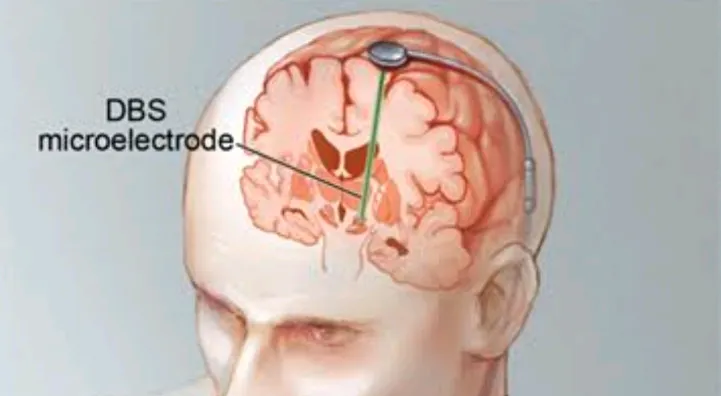DBS - Deep brain stimulation for Pakinson's
As of my last knowledge update in September 2021, deep brain stimulation (DBS) was already an established treatment for Parkinson's disease. DBS involves the implantation of a device that delivers electrical stimulation to targeted areas of the brain to help alleviate the motor symptoms of Parkinson's disease, such as tremors, rigidity, and slowness of movement.
While I do not have information on any specific new DBS device developments beyond 2021, it is likely that advancements have been made in the field of DBS technology since then. These advancements may include improvements in device design, electrode technology, targeting accuracy, programming interfaces, battery life, and connectivity features.
In recent years, researchers and companies have been working on developing more advanced DBS devices that offer increased precision, customization, and effectiveness in managing Parkinson's symptoms. These newer devices may incorporate features such as adaptive stimulation, closed-loop systems that adjust stimulation in real-time based on the patient's brain activity, advanced imaging techniques for more precise electrode placement, and improved battery technology for longer-lasting and rechargeable devices.
It is important to consult with a neurologist or movement disorder specialist who is knowledgeable about the latest advancements in DBS technology to get the most up-to-date information on available devices and treatment options for Parkinson's disease.
The success rate of deep brain stimulation (DBS) as a treatment for Parkinson's disease can vary depending on several factors, including the specific symptoms being targeted, the stage of the disease, the patient's overall health, and the expertise of the medical team performing the procedure.
Overall, DBS is considered to be an effective treatment for managing motor symptoms of Parkinson's disease, such as tremors, rigidity, and bradykinesia (slowness of movement), as well as reducing medication-related complications such as dyskinesias (involuntary movements).
Studies have shown that DBS can lead to significant improvements in motor symptoms and quality of life for many patients with Parkinson's disease. Success rates for DBS in Parkinson's disease are generally high, with a substantial percentage of patients experiencing significant symptom relief and improvement in their quality of life following the procedure.
However, it is important to note that DBS is not a cure for Parkinson's disease, and individual outcomes can vary. Some patients may experience only partial symptom relief, while others may not respond as well to the treatment. Additionally, DBS carries potential risks and complications, such as infection, hardware-related issues, and side effects from stimulation, which should be carefully considered and discussed with a healthcare provider.
Before undergoing DBS surgery, patients should have a thorough evaluation by a multidisciplinary team of healthcare professionals experienced in treating movement disorders to determine if they are good candidates for the procedure and to discuss the potential risks and benefits based on their individual circumstances.
© Simrans
While I do not have information on any specific new DBS device developments beyond 2021, it is likely that advancements have been made in the field of DBS technology since then. These advancements may include improvements in device design, electrode technology, targeting accuracy, programming interfaces, battery life, and connectivity features.
In recent years, researchers and companies have been working on developing more advanced DBS devices that offer increased precision, customization, and effectiveness in managing Parkinson's symptoms. These newer devices may incorporate features such as adaptive stimulation, closed-loop systems that adjust stimulation in real-time based on the patient's brain activity, advanced imaging techniques for more precise electrode placement, and improved battery technology for longer-lasting and rechargeable devices.
It is important to consult with a neurologist or movement disorder specialist who is knowledgeable about the latest advancements in DBS technology to get the most up-to-date information on available devices and treatment options for Parkinson's disease.
The success rate of deep brain stimulation (DBS) as a treatment for Parkinson's disease can vary depending on several factors, including the specific symptoms being targeted, the stage of the disease, the patient's overall health, and the expertise of the medical team performing the procedure.
Overall, DBS is considered to be an effective treatment for managing motor symptoms of Parkinson's disease, such as tremors, rigidity, and bradykinesia (slowness of movement), as well as reducing medication-related complications such as dyskinesias (involuntary movements).
Studies have shown that DBS can lead to significant improvements in motor symptoms and quality of life for many patients with Parkinson's disease. Success rates for DBS in Parkinson's disease are generally high, with a substantial percentage of patients experiencing significant symptom relief and improvement in their quality of life following the procedure.
However, it is important to note that DBS is not a cure for Parkinson's disease, and individual outcomes can vary. Some patients may experience only partial symptom relief, while others may not respond as well to the treatment. Additionally, DBS carries potential risks and complications, such as infection, hardware-related issues, and side effects from stimulation, which should be carefully considered and discussed with a healthcare provider.
Before undergoing DBS surgery, patients should have a thorough evaluation by a multidisciplinary team of healthcare professionals experienced in treating movement disorders to determine if they are good candidates for the procedure and to discuss the potential risks and benefits based on their individual circumstances.
© Simrans
Related Stories











